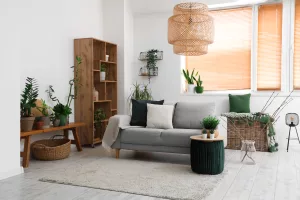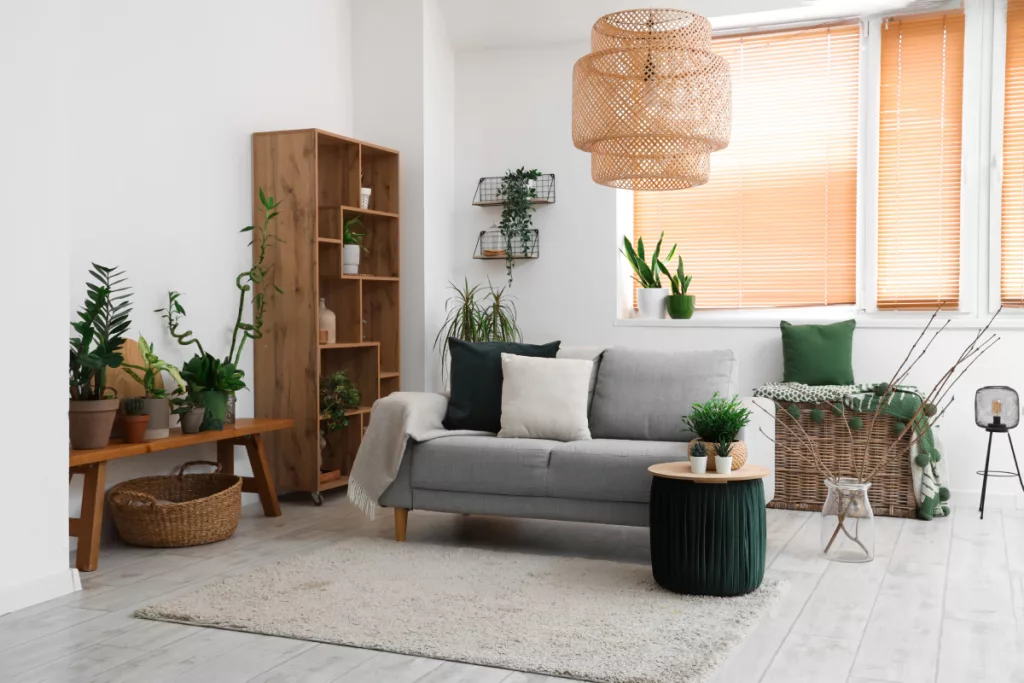
In this Article
Share
In our fast-paced world where environmental concerns are at the forefront of global discussions, sustainable living has become more than just a buzzword—it’s a way of life. This paradigm shift towards eco-consciousness has greatly influenced various aspects of our lives, including the realm of interior design.
Today, homeowners are increasingly seeking ways to create elegant, stylish living spaces that not only reflect their personal tastes but also minimise their environmental footprint. This article endeavours to delve into the notion of sustainable elegance within interior design and explore the burgeoning eco-friendly trends that are shaping the modern home.
Where Sustainability Begins in Home Design
Sustainability is no longer an afterthought but rather a guiding principle in interior design. From the materials we choose to the way we furnish and decorate our homes, every decision has the potential to impact the environment. Sustainable interior design is about making conscious choices that prioritise the health of the planet without compromising on style or comfort.
From flooring to furniture, opting for sustainable sources like reclaimed wood, bamboo, or recycled materials doesn’t just bring a touch of timeless sophistication; it’s a conscious choice that helps safeguard our planet’s precious resources. Reclaimed wood is a popular choice for flooring and furniture, adding rustic charm and character to any space while reducing the demand for new timber. Bamboo is prized for its rapid growth and versatility, making it an ideal choice for flooring, furniture, and décor accents.
In addition to furniture and flooring, textiles play a crucial role in interior design. Sustainable interior design trends emphasise the use of organic and natural fibers such as organic cotton, linen, hemp, and bamboo. These materials not only have a lower environmental impact but also add a soft, tactile quality to the room, creating a warm and inviting atmosphere. From curtains and upholstery to cushions and bedding, incorporating sustainable textiles into your home is a simple yet impactful way to embrace eco-friendly living.
When it comes to furnishings and décor accents, there is no shortage of eco-friendly options available. Recycled glass décor, for example, adds a touch of elegance and sophistication to any space while reducing waste and conserving resources. Repurposed wood accents and sustainable lighting fixtures are also popular choices for homeowners looking to add character and charm to their interiors without compromising on sustainability.

Sustainable Interior Decorating Tips
To guide homeowners in their pursuit of sustainable interior design, a plethora of eco-conscious decorating tips are available. From opting for eco-friendly materials to embracing minimalism and promoting water conservation, these strategies pave the way towards crafting living spaces that are both stylish and environmentally conscious, thereby reflecting your values and contributing to a healthier planet.
- Choose Eco-Friendly Materials: Opt for furniture and decor crafted from sustainable materials like reclaimed wood, bamboo, recycled metal, or organic fabrics to reduce your environmental footprint. Be diligent in researching the practices of the companies you buy from to ensure their commitment to sustainability.
- Upcycle and Repurpose: Get creative with your decor by upcycling old furniture or repurposing materials. For example, you can turn old pallets into coffee tables, or transform vintage crates into shelving units. This not only reduces waste but also adds unique character to your space.
- Embrace Minimalism: Adopt a minimalist approach to interior decorating by decluttering your space and focusing on quality over quantity. Choose a few statement pieces that serve both aesthetic and functional purposes, rather than filling your home with unnecessary items.
- Invest in Energy-Efficient Lighting: Switch to energy-efficient LED bulbs and fixtures to reduce energy consumption and lower your electricity bills. Consider installing dimmer switches or motion sensors to further optimise your lighting usage.
- Harness Natural Light: Maximise natural light in your home by strategically placing windows, skylights, and glass doors. Not only does natural light create a warm and inviting atmosphere, but it also reduces the need for artificial lighting during the day.
- Opt for Low VOC Paints: Choose paints and finishes that are low in volatile organic compounds (VOCs) to minimise indoor air pollution and promote better indoor air quality. Look for eco-friendly paint brands that offer non-toxic and low-odour options for a healthier living environment.
- Integrate Indoor Plants: Incorporate indoor plants into your decor to improve air quality, reduce stress, and enhance the overall ambience of your space. Choose low-maintenance houseplants that thrive indoors and complement your interior style, contributing to a sense of well-being.
- Support Local and Artisanal Craftsmanship: Source decor items and furniture from local artisans and craftsmen to support small businesses and reduce the environmental footprint associated with long-distance transportation. Handmade, artisanal pieces also add a personal touch to your home.
- Consider Longevity and Durability: Invest in high-quality, durable furniture and decor pieces that are built to last. While sustainable materials are important, choosing items that stand the test of time reduces the need for frequent replacements and minimises waste in the long run.
- Embrace the 3 ‘R’s: Practice the principles of reduce, reuse, and recycle throughout your interior decorating process. Choose products with minimal packaging, repurpose old items whenever possible, and recycle materials to minimise your environmental impact. Before making new purchases, consider exploring your own home or reaching out to loved ones for potential items to repurpose.
- Promote Sustainable Water Usage: Install water-saving fixtures and appliances like low-flow toilets and faucets, and incorporate water-efficient landscaping techniques such as drought-tolerant plants and efficient irrigation systems to reduce water waste, lower bills, and promote environmental stewardship.
In conclusion, sustainable interior design is not just a passing trend; it’s a mindful approach to creating spaces that are not only elegant and cosy but also kind to the planet. By integrating eco-friendly materials and practices into our homes, we not only manifest a commitment to sustainable living but also contribute to the creation of environments that harmonise with nature, thereby fostering a healthier, more sustainable future for all.
Next Articles

A Guide to Award-Winning Culinary Hotspots in Greater Palm Springs
Greater Palm Springs is not just about celebrity homes, mid-century modern pools, wellness retreats, and San Jacinto Mountain views

VACHERON CONSTANTIN Diwali Collection 2025
Fari Islands, Maldives, 30 July 2025 – Born from the Fari Islands’ founding vision as “The Home of Island Artistry,” where ‘Fari’ (“beautiful” in Dhivehi) captures not just scenic wonder but the deeper beauty of cultural connection

